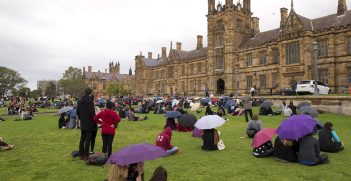Welcome to the Age of Bio-Surveillance

COVID-19 has transformed surveillance. From shotgun temperature checks to sewage monitoring at the microbiological level, the manner in which biological metadata is being targeted, acquired, analysed, and reported has changed.
This is an article published earlier this year and selected by our committee of commissioning editors as one of the best of 2020.
These new levels of surveillance are unlikely to fade away any time soon. We ought to expect that the genomic attribution of viral transfer will become an enduring method of emerging infectious disease monitoring. This will likely have large benefits for our understanding of cross-border transmission patterns and the ongoing risks of zoonosis – that is, the risk of disease transmission from animals to humans. A more granular characterisation of pathogen burden in the community is indeed a good thing. Charting the base point mutations of each viral instance has been a long-awaited capability made possible by advances in next-generation DNA sequencing technologies.
There are, however, dual uses enabled by population-wide bio-surveillance when conducted at the microbiological level. The old security maxim, “capabilities remain while intentions can change” remains indelibly relevant. Normalising genetic harvesting on a mass scale today could have far-reaching consequences tomorrow. It is important we understand the potential downsides to an ongoing regime of DNA-based viral surveillance. These issues are inherently transnational, if simply because they are about the confluence of life as information, and information can cross borders with incredible ease.
A recent report from the Australian Strategic Policy Institute (ASPI), “Genomic Surveillance: Inside China’s DNA Dragnet,” hints at what technologically sophisticated actors can achieve through DNA-based surveillance. The US may not be undertaking a similar dragnet exercise, but it is beginning to repurpose genetic information for policing that was originally collected for ancestry tracing and genetic counselling purposes. While much of the contemporary uses for DNA-based surveillance support criminal investigation techniques after the fact of a crime, this is unlikely to remain the case for long. Diverging international standards and ethical thresholds for artificial intelligence-based predictive policing suggest DNA may become just another data point in this process. After all, it is the ultimate unique identifier for a human, and an increasingly accurate identifier for probabilistic models of behaviour and illness. This is important because the DNA surveillance of COVID-19 offers a unique vector for the illicit capture of accompanying human DNA.
Now DNA data harvesting might not be an issue for Australia. Australia is a country supported by high quality health systems and a democratised approach to data privacy. We can expect that Australian DNA surveillance will adhere to community expectations and not suddenly veer off into dystopia. That is not the case elsewhere in the world.
This is where the inherent complexity of pandemic emergency response arises. The convergence of geopolitics, vaccine diplomacy, and shifting Indo-Pacific power distributions has real consequences for the privacy of human genetic material. The equipment, location, and supply chains that enable DNA surveillance require ongoing critical engagement. And it’s not just the primary collection points for biological material that matter, it’s also the cybersecurity of digital health informatics solutions.
We live in a world where biological metadata is persistently and pervasively collected. Heart rate, step count, sleep patterns, facial identification, gait pattern, blood oxygen levels – the ins and outs of our bodies are increasingly well defined in digital formats. Such commercially acquired biometrics will become of increasing interest to technologically sophisticated actors.
We may be at the dawn of DNA-based bio-surveillance, but we are also at the dawn of social genomics. Modern techniques for generating big data insights tend to be built on channelling existing information acquisition programs (licit and illicit) into a lake of unstructured digital information. Once information is in the lake, deep learning algorithms can figure out what correlates with what. Social genomics is another layer to this process, arising from correlations of cyber-biological patterns with genomic and facial recognition data.
Correlation is not causation, but herein lie some unsettling truths. If a technologically sophisticated actor is interested in preserving a racially motivated status quo, socially deterministic insights can be incredibly useful. Humanity has lived through the consequences of this thinking before, and the early 20th century practices of eugenics cast a long shadow. They are the reason we have the Universal Declaration of Human Rights, and they are the reason human research ethics exist.
But as the tools of bio-surveillance merge with the murky world of grey zone operations and shifting ethical, legal, and social standards, this history may no longer matter. Can your DNA be used to better target information and influence campaigns to you through social media? Can DNA be used to isolate, track, and calculate predictive policing scores for specific ethnic groups or specific genetic markers? It’s unlikely to be university research programs that will seek answers to these problem statements. It’s far more likely to be Chinese and American corporations operating with social license from law enforcement agencies.
Australia needs to step up when it comes to the regional provision of DNA surveillance tools for managing emerging infectious disease outbreaks. We can and should become the trusted regional provider of DNA surveillance, DNA storage, and the accompanying big data health informatics. Another recent ASPI report highlights the opportunity.
Many countries throughout the Indo-Pacific need sovereign DNA surveillance capabilities to manage emerging infectious disease outbreaks today and in the future. If Australia provides a transparent and open technology platform in support of this, we can ensure the destruction of human DNA that accompanies medical testing protocols. We can ensure human DNA is not surreptitiously collected as an informational input for tomorrow’s world of shifting ethical standards.
The US and China are changing the ethical, social, and legal dimensions that underpin this new era of bio-surveillance. Australia needs to be on the front foot in supporting the region through this moment of transition. Australia needs to support a democratised approach to biotechnology development and a transparent approach to genetic information privacy. We can no longer afford to wait. The greatest biological event to occur in a century compels Australia to act now.
Thom Dixon is Vice President for the Australian Institute of International Affairs NSW.
This article is published under a Creative Commons License and can be republished with attribution.





